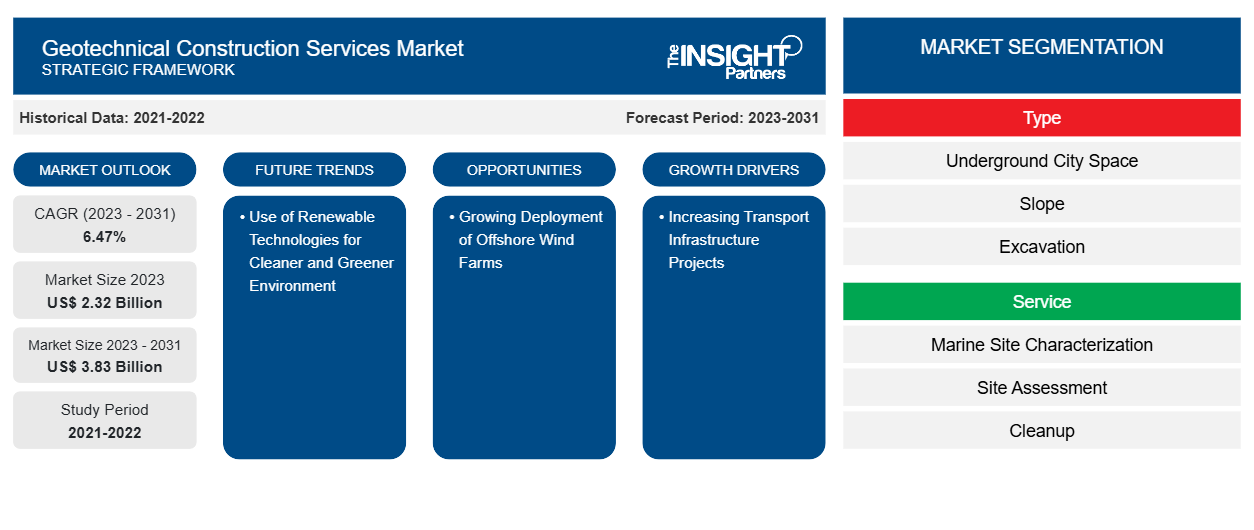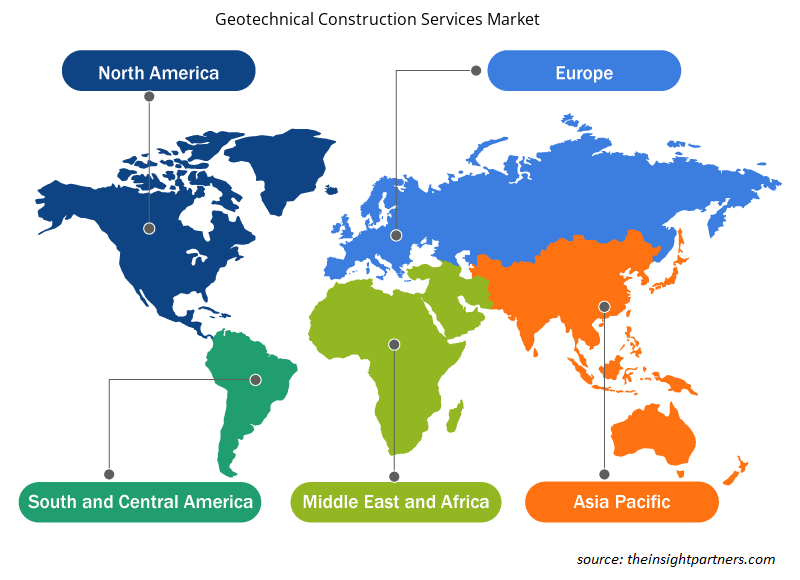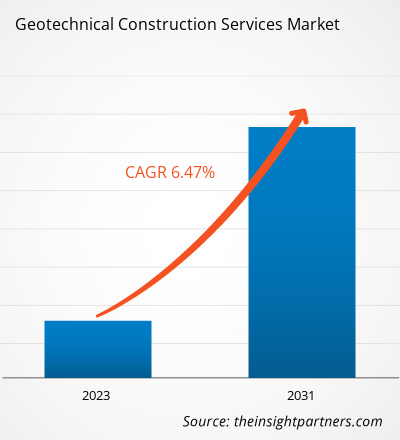Der Markt für geotechnische Baudienstleistungen wurde im Jahr 2024 auf 2,67 Milliarden US-Dollar geschätzt und soll bis 2031 3,83 Milliarden US-Dollar erreichen; für den Zeitraum 2025–2031 wird eine durchschnittliche jährliche Wachstumsrate (CAGR) von 6,2 % erwartet.
Geotechnische Dienstleistungen werden neben dem Bauwesen auch in der Öl- und Gasindustrie sowie im Bergbau eingesetzt. Der Markt für geotechnische Dienstleistungen wird maßgeblich durch die hohen Investitionen staatlicher Stellen in Bauvorhaben in Schwellenländern angetrieben. Darüber hinaus wird erwartet, dass Fortschritte bei Öl- und Gasprojekten in den kommenden Jahren der geotechnischen Instrumentierungs- und Überwachungsbranche zugutekommen werden.
Marktanalyse für geotechnische Baudienstleistungen
Der Markt für geotechnische Baudienstleistungen umfasst folgende Akteure: Bauunternehmen, Spezialisten für geotechnische Baudienstleistungen, Hersteller geotechnischer Bauinstrumente und Anwendungen. Bauunternehmen kontaktieren verschiedene Anbieter geotechnischer Baudienstleistungen, bevor sie mit dem Bau beginnen. Flach- und Tiefgründungen, Damm- und Absetzbeckenentwürfe, Stabilitätsanalysen für Böschungen und Aushubarbeiten, Bodenverbesserungspläne, Bodenanker und Bodennägel, Hochwasserschutzstrukturen, Entwurf von Fugenmörtelvorhängen, Straßenbeläge, Abfallrückhaltebecken und Lagunen, Tunnelplanung und die Planung von unterirdischen Bauwerken sind nur einige der Dienstleistungen, die diese Spezialisten für Bauunternehmen erbringen. Arup, EGS, Fugro und Geosyntec Consultants, Inc. sind einige Unternehmen, die Beratungsleistungen für Bautätigkeiten anbieten. Die Spezialisten für geotechnische Bauarbeiten verwenden verschiedene Geräte wie Proctor-Verdichtungs- und Dichtemessgeräte, Universalprobenentnahmegeräte, Erdwiderstandsprüfer, elektronische Digitalwaagen und vieles mehr zu Prüfzwecken. Die oben genannten geotechnischen Bauleistungen werden für eine Reihe von Anwendungen eingesetzt, beispielsweise für Eisenbahnen, Flughäfen, Tunnel, Gewerbe- und Wohngebäude , Anlagen und Fabriken.
Marktübersicht für geotechnische Baudienstleistungen
Mineralien bilden das Rückgrat der menschlichen Zivilisation, da ihre Verwendung in verschiedenen Bereichen deren Entwicklung vorangetrieben hat. Mineralien und daraus hergestellte Produkte finden Anwendung in Branchen wie Energieerzeugung, Fertigung, Chemie und Petrochemie, Gesundheits- und Pharmaindustrie sowie im Bauwesen. Die Errichtung eines Bergbaustandortes erfordert geotechnisches und erdbauliches Know-how für die Kartierung über und unter Tage, die Analyse der unterirdischen Stützung, die Planung von Abbauräumen, Schächten, Gefällestrecken, Stollen und Tunneln, Senkungsuntersuchungen, die Untersuchung und Planung von Schächten und Stollen, die Kartierung geologischer Aufschlüsse, geophysikalische Oberflächenuntersuchungen, die Planung von Trinkwasser-, Industrie- und Abraumdämmen usw. Derzeit gehören Kohle, Gold, Eisenerz, Aluminium und Kupfer aufgrund ihrer breiten Verwendung im Industriesektor zu den am häufigsten geförderten Mineralien. Der steigende Bedarf an Mineralien fördert die Expansion der Bergbauindustrie und treibt damit das Wachstum des Marktes für geotechnische Baudienstleistungen voran.
Sie erhalten kostenlos Anpassungen an jedem Bericht, einschließlich Teilen dieses Berichts oder einer Analyse auf Länderebene, eines Excel-Datenpakets sowie tolle Angebote und Rabatte für Start-ups und Universitäten
Markt für geotechnische Baudienstleistungen: Strategische Einblicke

-
Informieren Sie sich über die wichtigsten Markttrends in diesem Bericht.Dieses KOSTENLOSE Beispiel umfasst eine Datenanalyse, die von Markttrends bis hin zu Schätzungen und Prognosen reicht.
Markttreiber und Chancen für geotechnische Baudienstleistungen
Zunehmende Verkehrsinfrastrukturprojekte
Die Verkehrsinfrastruktur spielt eine entscheidende Rolle für die Entwicklung jeder Volkswirtschaft. Sie ist unverzichtbar für die reibungslose Produktion und Verteilung von Gütern sowie für das Gedeihen des Tourismus und des Gastgewerbes. Straßen, Häfen, Flughäfen und Eisenbahnen sind komplexe Ingenieurprojekte, die geotechnisches Bauwissen erfordern. Angesichts der wachsenden Bedeutung der wirtschaftlichen Entwicklung investieren die Regierungen verschiedener Industrie- und Entwicklungsländer erheblich in die Entwicklung ihrer Verkehrsinfrastruktur. Beispielsweise plant die chinesische Regierung bis 2035 den Bau von 215 zusätzlichen Flughäfen. Im März 2021 kündigte die chinesische Regierung ihren Plan zum Bau einer 1.011 km langen Eisenbahnlinie an, die Chengdu mit Linzhi verbinden soll. Die Projektkosten belaufen sich auf ca. 48 Milliarden US-Dollar. Im Jahr 2020 erhielt das Projekt des weltweit längsten Absenktunnels für Eisenbahn und Straße zwischen Deutschland und Dänemark grünes Licht. Der Tunnel wird von Femern A/S gebaut. Im September 2020 wurde der Bau des Ceneri-Basistunnels abgeschlossen. Der Eisenbahntunnel soll künftig das Mittelmeer und die Nordsee verbinden. Im Juni 2018 begann die schwedische Regierung mit der Umsetzung des Nationalen Verkehrsplans für 2018–2029 mit einem Gesamtbudget von rund 76 Milliarden US-Dollar. Der Plan konzentriert sich auf den Bau mehrerer neuer Eisenbahnstrecken sowie die Modernisierung und Aufrüstung des bestehenden Schienennetzes. Im November 2020 genehmigte die britische Regierung das Stonehenge-Road-Tunnelprojekt im Wert von 2,2 Milliarden US-Dollar. Im Juni 2019 kündigte die kanadische Regierung ein 500 Millionen US-Dollar teures Projekt für den Wiederaufbau des längsten Autobahntunnels des Landes an. Diese starke staatliche Betonung der Entwicklung und Verbesserung der Verkehrsinfrastruktur ebnet den Weg für das Wachstum des Marktes für geotechnische Baudienstleistungen.
Zunehmender Einsatz von Offshore-Windparks
Die Regierungen europäischer Länder legen derzeit aufgrund der relativ flachen Gewässer den Schwerpunkt ihrer Offshore-Windenergienutzung auf die Nordsee. Mit der Weiterentwicklung schwimmender Technologien haben jedoch in den letzten Jahren auch die Mittelmeer- und Atlantikküste stärker in den Fokus gerückt. Das Wind Energy Technologies Office in den USA fördert landesweite Forschung zur Entwicklung von Offshore-Windtechnologien, die die Windressourcen vor den US-Küsten nutzen und in Energie umwandeln. Ein derart vielfältiges Portfolio an Forschungs-, Entwicklungs- und Demonstrationsprojekten wird es der Branche ermöglichen, grundlegende Hindernisse im Zusammenhang mit der Entwicklung von Offshore-Windenergie zu überwinden. Dazu gehören vergleichsweise hohe Strom- und Installationskosten, Umweltschutzmaßnahmen, technische Herausforderungen und Probleme beim Netzanschluss. Die Entwicklung von Offshore-Windparks wird daher im Prognosezeitraum die Inanspruchnahme geotechnischer Baudienstleistungen fördern.
Segmentierungsanalyse des Marktberichts für geotechnische Baudienstleistungen
Schlüsselsegmente, die zur Ableitung der Marktanalyse für geotechnische Baudienstleistungen beigetragen haben, sind Typ und Dienstleistungen.
- Je nach Typ ist der Markt in unterirdische Stadträume, Hang- und Baugruben sowie Boden und Fundamente unterteilt. Das Segment Paneeltüren hatte im Jahr 2023 einen größeren Marktanteil.
- Der globale Markt für geotechnische Baudienstleistungen ist nach Mechanismen in die Bereiche Meeresstandortcharakterisierung, Standortbewertung und -sanierung, Standorttechnik und -design, Umweltplanung und -management und weitere unterteilt. Das Schwingsegment hatte 2023 einen größeren Marktanteil.
Geotechnische Baudienstleistungen Marktanteilsanalyse nach Geografie
Der Marktbericht für geotechnische Baudienstleistungen umfasst Nordamerika (USA, Kanada und Mexiko), Europa (Spanien, Großbritannien, Deutschland, Frankreich, Italien und das übrige Europa), den asiatisch-pazifischen Raum (Südkorea, China, Indien, Japan, Australien und den übrigen asiatisch-pazifischen Raum), den Nahen Osten und Afrika (Südafrika, Saudi-Arabien, die Vereinigten Arabischen Emirate und den übrigen Nahen Osten und Afrika) sowie Süd- und Mittelamerika (Brasilien, Argentinien und den übrigen Süd- und Mittelamerika). Gemessen am Umsatz dominierte der asiatisch-pazifische Raum im Jahr 2023 den Marktanteil geotechnischer Baudienstleistungen. Nordamerika leistete den zweitgrößten Beitrag zum globalen Markt für geotechnische Baudienstleistungen, gefolgt von Europa.
Regionale Einblicke in den Markt für geotechnische Baudienstleistungen
Die Analysten von Insight Partners haben die regionalen Trends und Faktoren, die den Markt für geotechnische Baudienstleistungen im Prognosezeitraum beeinflussen, ausführlich erläutert. In diesem Abschnitt werden auch die Marktsegmente und die geografische Lage für geotechnische Baudienstleistungen in Nordamerika, Europa, Asien-Pazifik, dem Nahen Osten und Afrika sowie Süd- und Mittelamerika erläutert.

- Erhalten Sie regionale Daten zum Markt für geotechnische Baudienstleistungen
Umfang des Marktberichts für geotechnische Baudienstleistungen
| Berichtsattribut | Details |
|---|---|
| Marktgröße im Jahr 2024 | 2,67 Milliarden US-Dollar |
| Marktgröße bis 2031 | 3,83 Milliarden US-Dollar |
| Globale CAGR (2025 – 2031) | 6,2 % |
| Historische Daten | 2021-2023 |
| Prognosezeitraum | 2025–2031 |
| Abgedeckte Segmente |
Nach Typ
|
| Abgedeckte Regionen und Länder |
Nordamerika
|
| Marktführer und wichtige Unternehmensprofile |
|
Marktteilnehmerdichte im Bereich geotechnische Baudienstleistungen: Auswirkungen auf die Geschäftsdynamik
Der Markt für geotechnische Baudienstleistungen wächst rasant. Die steigende Nachfrage der Endverbraucher ist auf Faktoren wie veränderte Verbraucherpräferenzen, technologische Fortschritte und ein stärkeres Bewusstsein für die Produktvorteile zurückzuführen. Mit der steigenden Nachfrage erweitern Unternehmen ihr Angebot, entwickeln Innovationen, um den Bedürfnissen der Verbraucher gerecht zu werden, und nutzen neue Trends, was das Marktwachstum weiter ankurbelt.
Die Marktteilnehmerdichte beschreibt die Verteilung der in einem bestimmten Markt oder einer bestimmten Branche tätigen Unternehmen. Sie gibt an, wie viele Wettbewerber (Marktteilnehmer) in einem bestimmten Marktraum im Verhältnis zu dessen Größe oder Gesamtmarktwert präsent sind.
Die wichtigsten Unternehmen auf dem Markt für geotechnische Baudienstleistungen sind:
- Arup
- EGS
- Fugro
- Gardline Limited
- Geosyntec Consultants, Inc.
- HDR
Haftungsausschluss : Die oben aufgeführten Unternehmen sind nicht in einer bestimmten Reihenfolge aufgeführt.

- Überblick über die wichtigsten Akteure auf dem Markt für geotechnische Baudienstleistungen
Marktnachrichten und aktuelle Entwicklungen im Bereich geotechnische Baudienstleistungen
Der Markt für geotechnische Baudienstleistungen wird durch die Erhebung qualitativer und quantitativer Daten aus Primär- und Sekundärforschung bewertet. Dazu zählen wichtige Unternehmenspublikationen, Verbandsdaten und Datenbanken. Im Folgenden finden Sie eine Liste der Entwicklungen und Strategien im Markt für geotechnische Baudienstleistungen:
- Im Juli 2021 gründete HDR in Kanada ein spezialisiertes, multidisziplinäres Ingenieurbüro für Gebäudetechnik, um das langjährige Architektur- und Ingenieurportfolio für kanadische Kunden zu erweitern. Der Schritt folgt auf die Übernahme der Hurley Palmer Flatt Group im Juli 2019, einem unabhängigen britischen Ingenieurbüro, das Lösungen für die gebaute Umwelt anbietet. (Quelle: HDR, Pressemitteilung/Unternehmenswebsite/Newsletter)
Marktbericht zu geotechnischen Baudienstleistungen – Umfang und Ergebnisse
Der Bericht „Marktgröße und Prognose für geotechnische Baudienstleistungen (2021–2031)“ bietet eine detaillierte Analyse des Marktes, die die folgenden Bereiche abdeckt:
- Marktgröße und Prognose auf globaler, regionaler und Länderebene für alle wichtigen Marktsegmente, die im Rahmen des Berichts abgedeckt sind
- Marktdynamik wie Treiber, Hemmnisse und wichtige Chancen
- Wichtige Zukunftstrends
- Detaillierte Porter's Five Forces Analyse
- Globale und regionale Marktanalyse mit wichtigen Markttrends, wichtigen Akteuren, Vorschriften und aktuellen Marktentwicklungen
- Branchenlandschaft und Wettbewerbsanalyse, einschließlich Marktkonzentration, Heatmap-Analyse, prominenten Akteuren und aktuellen Entwicklungen
- Detaillierte Firmenprofile mit SWOT-Analyse
- Historische Analyse (2 Jahre), Basisjahr, Prognose (7 Jahre) mit CAGR
- PEST- und SWOT-Analyse
- Marktgröße Wert/Volumen – Global, Regional, Land
- Branchen- und Wettbewerbslandschaft
- Excel-Datensatz
Aktuelle Berichte
Erfahrungsberichte
Grund zum Kauf
- Fundierte Entscheidungsfindung
- Marktdynamik verstehen
- Wettbewerbsanalyse
- Kundeneinblicke
- Marktprognosen
- Risikominimierung
- Strategische Planung
- Investitionsbegründung
- Identifizierung neuer Märkte
- Verbesserung von Marketingstrategien
- Steigerung der Betriebseffizienz
- Anpassung an regulatorische Trends






















 Kostenlose Probe anfordern für - Markt für geotechnische Baudienstleistungen
Kostenlose Probe anfordern für - Markt für geotechnische Baudienstleistungen